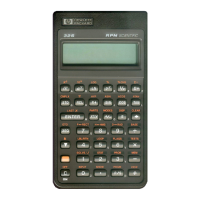024
* Divides previous result by the magnitude.
D25
flCOS
Calculates angle.
026
STO
G
027
VIEW
G Displays angle.
028
GTO
P Loops back for polar display
/input.
Bytes
and
Checksum: 042.0, 739F
Flags
Used:
None.
Memory
Required: 280.5 bytes: 192.5 for program, 88 for variables.
Remarks:
The length of routine S can be shortened by 6.5 bytes.
The value
—1
as shown uses 9.5 bytes. If it appears as 1 followed by
+/-
, it will require only 3 bytes. To do this, you must key in a
dummy
step
between the 1
and
the
+/-,
and
then
delete the
dummy
step.
The terms 'polar*
and
"rectangular," which refer to two-dimensional
systems, are used instead of the proper three-dimensional terms of
"spherical*
and
'Cartesian.* This stretch of terminology allows the la
bels to be associated with their function without confusing conflicts.
For
instance,
if
LBL C
had
been
associated
with
Cartesian
coordinate
input, it would not have been available for cross product.
Program
Instructions:
1. Key in the program routines; press
QT)
when
done.
2. If your vectoris in rectangular form, pressIxeqIRand go to step
4. If your vector is in polar form, press I
XEQ
IP and continue with
step 3.
3.
Key
in R and pressI
R/S
I,key in Tand pressIR/s
I,
and key in P
and press IR/SI. Continue at step 5.
4. Key in X and press IR/s I, key in Yand press IR/s
I,
and key in Z
and
press IR/SI.
5.
To
key in a second vector, press IxeqI E (for enter) and go to
step 2.
170
12:
Mathematics
Programs

